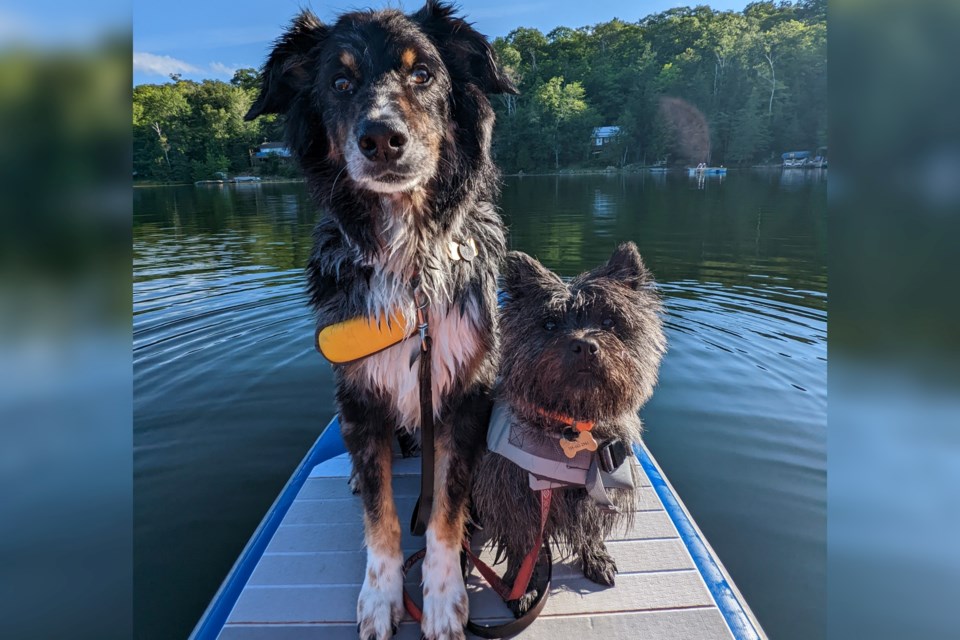As the weather warms, we have traded out snowblowers and boots for lawnmowers and sandals. Some of us are dusting off the camping gear while others are stockpiling antihistamines.
For our pets, there are a few injuries that are seen more commonly in the summer. Rising temperatures increase the frequency of hot spots. Heat stress, porcupines and skunks are more prevalent, and soft tissue injuries from fishing hooks, fences, sticks or animal bite wounds become more frequent.
Hot spots
Hot spots are raw, moist, incredibly itchy lesions on the skin that start small, but spread quickly due to self-trauma (licking, scratching, chewing) at the area. The initial cause of the lesion can be due to a number of things — not drying properly after swimming, an underlying allergy, injury or external parasites, for example.
The key to treatment for hot spots is to control pain, inflammation and infection.
Step one: Remove the surrounding fur to allow the lesion to dry out; this is done with clippers not scissors. It’s very easy to slip or have your pet move and accidentally cut the skin with scissors.
Step 2: Disinfection. Thoroughly clean the area with antibacterial soap and dry.
Step 3: Anti-inflammatory and antibacterial treatment. This can be topically or orally, or with an injectable, depending on the severity of the hot spot.
Hot spots are every itchy and can be extremely painful. While some cases may be able to be treated at home, others will require a visit to the veterinary clinic and possibly sedation to be treated properly. When in doubt – call your vet.
Heat stress also known as heat stroke is the rise in body temperature due to the inability to dissipate body heat. Dogs dissipate heat mainly through their paws and panting. Factors that make dogs more susceptible to heat stress are obesity, brachycephalic (short muzzled) dog breeds, heart or pulmonary disease. Environmental factors that lead to heat stress are high humidity, poor ventilation, and water deprivation.
Heat stress
Signs of heat stress in dogs is excessive panting, laboured breathing, drooling, unco-ordinated and lethargic behaviour, which untreated can lead to collapse.
Quick action is required. Bring your pet out of the heat, offer them water and cool them by applying wet, lukewarm cloths over their skin and paws. Putting a fan in front of their face will help them cool faster.
Start the cooling process before calling your veterinarian, as it is fundamental to reduce tissue damage and save your pet.
Porcupines
The start of spring in a veterinary office is marked not by the first robin sighting but rather by the first dog vs porcupine.
Spoiler alert — the dog rarely wins, and if they do, the porcupine still gets the last laugh. Quills are barbed, and the longer they are in the skin the deeper they get.
While the temptation may be to try to remove these at home, because of the barbs they are very painful to remove and should only be removed under sedation. Try to prevent your dog from pawing or trying to remove the quills themselves as this can break the quills and they may need to be surgically removed.
As stated quills, do migrate, and can cause severe injury, so quick treatment is recommended.
Skunk
Skunk spray — while inconvenient and nauseating — rarely will cause harm to your pet. There is a possibility of allergic reaction. As well, if a large amount of the spray is swallowed, it can cause toxic effects. Mostly, though, it is just the smell to contend with.
There are special shampoos and home remedies that can be tried. Whatever method you choose, it is likely to take a few weeks to go away completely and will resurface when they get wet.
Soft tissue injuries
Treatment for fish hook injuries, bite wounds, and cuts depends on the severity and location of the wound.
Fish hooks injuries will often require sedation to remove the barbed hooks, particularly with two or three barbs.
Bite wound treatment is more tricky as bites seed bacteria deep in the soft tissue and can lead to an iceberg effect — infection that is deep and unseen for several days after the initial injury. As these are “dirty” wounds, depending on the size, they may be left open to drain.
Cuts (lacerations) may require closure (sutures or staples) depending on the location and size of the wound. Smaller cuts will heal without closure, but when wounds are large or in areas of high motion, sutures will allow them to heal faster with fewer complications.
There is a lot of fun to be had outside with your pets in the summer, but accidents do happen. Having a pet first aid kit, and making sure you know what the emergency services are in the area will help to take some of the stress away if an urgent situation occurs.
Dr. Courtney Andrews is a veterinarian at Lockerby Animal Hospital, a graduate of the Royal School of Veterinary Studies and dog mom to Argyll and Einstein. Animals & Pets is made possible by our Community Leaders Program.



